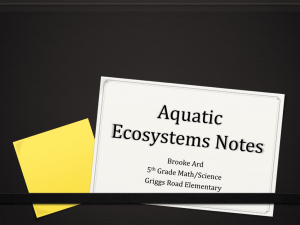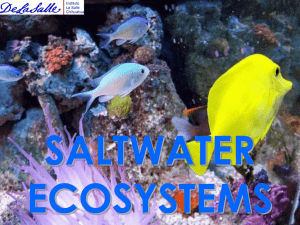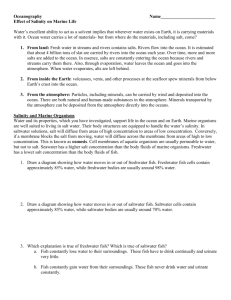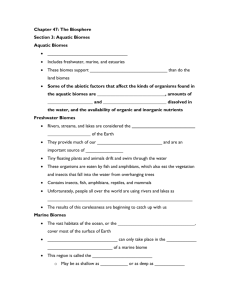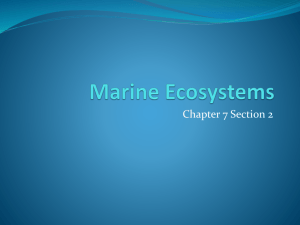Ecosystems - Wikispaces
advertisement
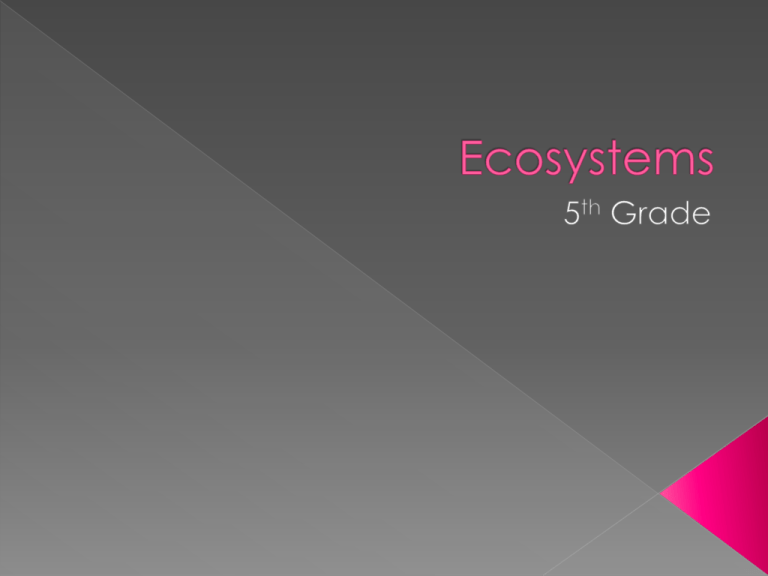
Ecosystem: all of the living and nonliving things in an area Abiotic Factor: nonliving parts of an ecosystem Biotic Factor: living parts of an ecosystem Population: all of the organisms of a species living in the same area Community: all of the populations living in an area Ecology: study of how all things in an ecosystem interact Ecologist: scientists who study ecology Habitat: the place where organisms live Niche: role of an organism in the community Herbivore: an animal that only eats plants or algae Carnivore: an animal that only eats other animals Omnivore: an animal that eats both plants and animals Scavenger: a meat eating animal that feeds on the remains of dead animals Producer: a plant (produces its own food and creates food and oxygen for animals) Consumer: an animal that eats plants and animals (consumes its food rather than making its own food) Decomposer: break down dead plants and animals into useful things like minerals and nutrients (bacteria, worms, some bugs, and fungi) Predator: an animal that hunts other animals for food Prey: a living thing that is hunted for food Symbiosis: a relationship between two kinds of organisms that lasts over time Mutualism: a relationship between two kinds of organisms that benefits both Parasitism: a relationship in which one organism lives in or on another organism and benefits from that relationship while the other organism may be harmed by it Commensalism: a relationship between two kinds of organisms that benefits one without harming the other Starts with the sun and ends with the decomposers The arrow points to the predator Displays the movement of energy Displays the interactions between organisms, specifically who eats what Arrows point to the prey Multiple food chains If one organism is taken out of the web, it affects all of the other organisms (predators die due to lack of food and prey increases population because its predator is no longer hunting it for food) Displays the amount of energy each type of organism receives Producers receive all of the energy from the sun to make their food Carnivores receive the least amount of energy Limiting factor: anything that controls the growth or survival of a population Carrying capacity: the maximum population size that an area can support Endangered species: a species that is in danger of becoming extinct Extinct: a species that has died out completely Threatened species: a species that is in danger of becoming endangered Population Urban growth Deforestation Mining Protecting a species Recycle, reduce, re-use Fertilizer: human made material that add nutrients to the soil Composting: human made fertilizer made from dead materials that turns into fertilizer when decomposers break it down Inexhaustible resource: cannot be depleted (sun) Non-renewable resource: a natural resource that cannot be replaced (oil) Raw Materials: material not yet refined, manufactured, or processed (wood, metal, etc…) Renewable resources: a natural resource that can be replaced (trees) Heat Source, evaporation, condensation, precipitation, run-off, groundwater, transpiration Animals role: perspiration and urination Plants give off oxygen and animals breath in the oxygen Animals give off carbon dioxide and plants breath in the carbon dioxide Carbon can in the form of burned materials Humans burn fossil fuels and give off carbon into the atmosphere Carbon dioxide is also given off when plants and animals die. This occurs when decomposers break down dead plants and animals and release the carbon compounds stored in them. Very often, energy trapped in the dead materials becomes fossil fuels which is used as combustion again at a later time. Animals eat food, animals then give off feces, and the decomposers break down the feces and dead materials in the ground into nitrogen (nutrients) for plants. Nitrogen is introduced to the soil by precipitation (rain, lightning) because it is 78% of our air. Ecological succession: the gradual replacement of one community by another Pioneer species: the first species living in an otherwise lifeless area Pioneer community: the first community thriving in a once lifeless area Climax community: the final stage of succession in an area, unless a major change happens Natural Changes: forest fire, volcanoes, overpopulation, land changes, flood, drought, severe storms, etc… Abandoned farms, cities, and houses Biome: large ecosystem that has its own kind of climate, soil, plants, and animals Study the charts on B64 and B65 Terrestrial (land biomes) › › › › › › Taiga (Coniferous Forest) Deciduous Forest Tropical Rain Forest Desert Tundra Grassland › › › › Marine (Ocean) Freshwater Salt Water Marshes Estuaries Aquatic (water biomes) Forests have many trees (with needles or with leaves), shrubs, grasses and ferns, and a variety of animals. They usually get more rain than grasslands. Diverse types of animals can be found in forests, depending on their type. Deciduous: black bear, deer, red fox, vole, rabbit, cardinal. Rain forest: panther, monkeys, capybara, snakes, spiders. Temperatures in the forests may vary depending on where the forest is located. Grasslands have fertile soil and are covered with tall grasses. They usually get a medium amount of rain, but less than forests. Temperatures may also vary depending on where the grassland is located. Some examples of animals that live in the grasslands are prairie dogs, bison, and grasshoppers. Aquatic Lakes and ponds are bodies of freshwater that are surrounded by land. Ponds are usually shallower than lakes and the temperature of the water usually stays the same from top to bottom. Plants and algae usually grow along the edges where the water is shallow. Some examples of animals may be different types of fish, amphibians, ducks, turtles, or beavers. Oceans are large bodies of saltwater divided by continents. Oceans have many types of ecosystems depending on the conditions (sunlight, temperature, depth, salinity) of that part of the ocean. Most organisms live where the ocean is shallow (from the shoreline to the continental shelf) because sunlight can reach deep and the water is warm making food abundant. Some examples of organisms that live in the shallow ocean are drifters (jellyfish or seaweed), swimmers (fish), crawlers (crabs), and those anchored to the ocean floor (corals). Some organisms live in the open ocean, near the surface or down to the deep ocean bottom. Plankton float in the upper regions of the water. Some organisms swim to the surface to find food or for air (whales, turtles, sharks) while others live closer to the bottom (certain fish, octopus, tubeworms). Salt Water Marsh Salt marshes are coastal wetlands that are flooded and drained by salt water brought in by the tides. They are marshy because the soil may be composed of deep mud and peat. Peat is made of decomposing plant matter that is often several feet thick. Peat is waterlogged, root-filled, and very spongy. Because salt marshes are frequently submerged by the tides and contain a lot of decomposing plant material, oxygen levels in the peat can be extremely low—a condition called hypoxia. Hypoxia is caused by the growth of bacteria which produce the sulfurous rottenegg smell that is often associated with marshes and mud flats. Salt marshes occur worldwide, particularly in middle to high latitudes. Thriving along protected shorelines, they are a common habitat in estuaries. In the U.S., salt marshes can be found on every coast. Approximately half of the nation's salt marshes are located along the Gulf Coast. These intertidal habitats are essential for healthy fisheries, coastlines, and communities—and they are an integral part of our economy and culture. They also provide essential food, refuge, or nursery habitat for more than 75 percent of fisheries species, including shrimp, blue crab, and many finfish. Salt marshes also protect shorelines from erosion by buffering wave action and trapping sediments. They reduce flooding by slowing and absorbing rainwater and protect water quality by filtering runoff, and by metabolizing excess nutrients. Estuaries An estuary is an area where seawater mixes with freshwater. Estuaries can be found along the coast. Each day as the tide rises, saltwater is brought into the estuary. Freshwater comes down the rivers and creeks and mixes with this saltwater. Plants found in estuaries need to be adapted to salty conditions Some plants, like pickle weed, can absorb the salt water and store the salt in special compartments, called vacuoles, in the leaves. Other plants, like salt grass and alkali heath, are able to push the salt out onto the surface of the leaves. The salt crystals can be seen if you look very closely. The decaying plants are eaten by microorganisms (animals so tiny you need a microscope to see them.) The microorganisms are eaten by small invertebrates (animals without backbones.) Fish, like carp and stickleback, then eat the invertebrates. Many of the fish we eat depend upon estuaries. They are sheltered places where fish can have their young and the young fish can grow before moving out into the open ocean. Without estuaries, the number of fish in our oceans would decrease greatly. Occasionally, water in certain areas of the estuary can dry up and all that is left is a mud flat. It may seem like there is no life in this mud flat at all, but there are all kinds of mussels, shrimp, worms and other invertebrates living in the mud. Often you can see birds probing the mud with their beaks looking for a tasty meal. There are a large number of birds found in estuaries. The migrating birds such as geese use them to rest and feed. There are also birds who are permanent residents of the estuaries. Many of these birds, such as the Great Blue Heron, and the Great Egret, have long legs that they use for wading in the water. Egrets are excellent at hunting fish. Some wiggle their toes in the sand to attract fish, which they can snap up for a meal. If you look at the different types of birds, you will notice that they all have different lengths of bills. This means that each type of bird is adapted to eating different things. This reduces the amount of direct competition between the birds and allows more types of birds to live in the same area. People and Estuaries: Everyone wants to live near the ocean, right? Unfortunately, in order to build houses near the ocean, estuaries were drained and filled in with dirt so that houses could be built on top of them. Many of our estuaries were destroyed before people realized their value.

